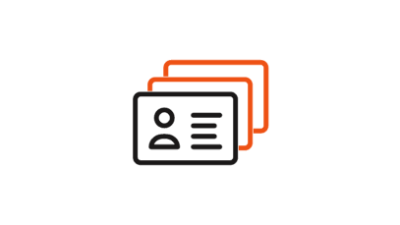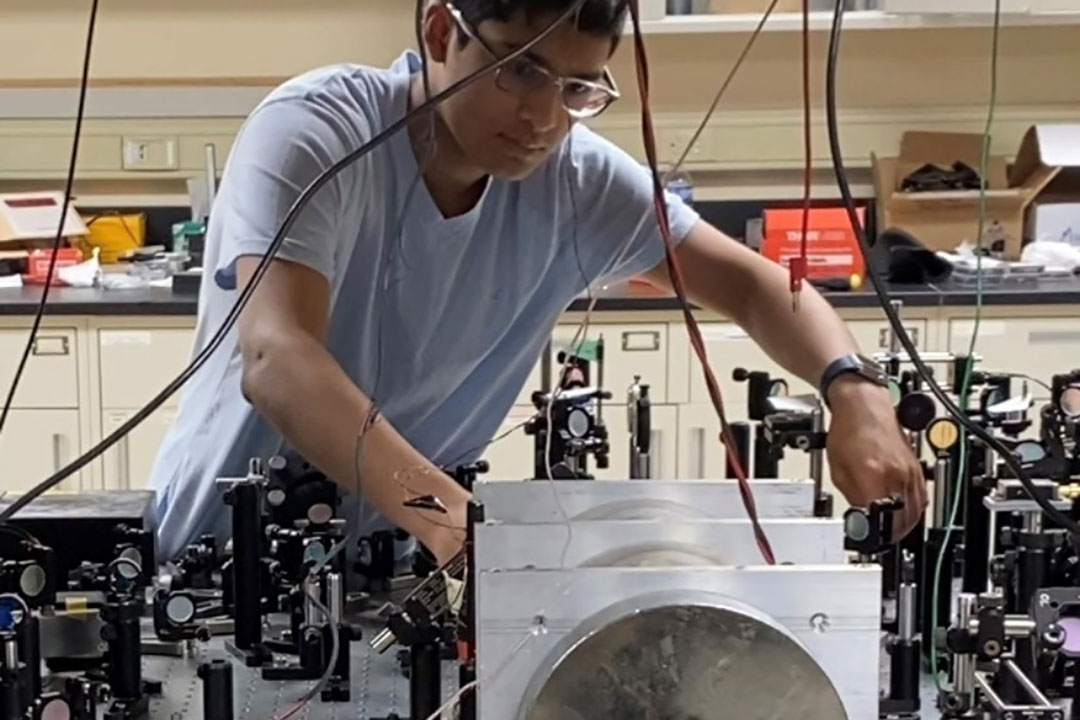Apprenticeship experience through AEOP puts high school student in quantum physics research at Miami University in Ohio
AEOP Apprenticeships and Fellowships is administered by RIT's K-12 University Center on behalf of the U.S. Army to provide paid, summer experiences to students interested in STEM
Muhammed Khan
Muhammed Khan, a senior from Talawanda High School in southwest Ohio, is working as an apprentice through the Army Educational Outreach Program with a team experimenting the development of quantum memory in atomic vapor. Under direction of Dr. Samir Bali, he’s among a group of other students, including those already attending college in an experience Khan said has allowed him the chance to “drastically expand” knowledge in scientific research. AEOP Apprenticeships and Fellowships is administered by Rochester Institute of Technology’s K-12 University Center on behalf of the U.S. Army.
A program supported by Rochester Institute of Technology’s K-12 University Center is providing an Ohio high school student with the chance to work alongside professional researchers, and undergrad and graduate students to help bolster his exposure in physics. The summer apprenticeship opportunity through the Army Educational Outreach Program is administered by RIT K-12 on behalf of the U.S. Army, and provides paid internship-like experiences in science, technology, engineering and math for high school through postdoctoral individuals at Army labs and partner universities across the country.
This summer, Muhammed Khan, a senior from Talawanda High School in southwest Ohio, is working as an AEOP apprentice with a team experimenting the development of quantum memory in atomic vapor. He’s among a group of other students, including those already attending college in an experience Khan said has allowed him the option to “drastically expand” knowledge in scientific research.
“(It) has given me ample time to establish myself in the lab, allowing me to accomplish much more through AEOP,” he said. “Being a part of the AEOP community once again has also provided me with a strong foundation in the world of STEM, along with great funding and resources.”
In his second year with the program, Khan is working with professor Samir Bali at Miami University that offers high school and undergraduate apprenticeships focused on physics, and which allow its participants to learn a versatile skillset in cutting-edge quantum optics techniques and hands-on training with experiments in quantum information. Through the summer experience, students develop in-depth familiarity with state-of-the-art optical devices, and acquire working knowledge of theoretical quantum computing approaches.
Khan is also working alongside undergrad student Reese Tyra, a physics and music composition major at the Oxford, Ohio-based university, who is using his passion in physics to also support his love of music.
We caught up with both students to learn more about their experiences.
How did you learn about Army Educational Outreach Program Apprenticeships and Fellowships?
Khan: Towards the end of my sophomore year, I was introduced to an opportunity for an apprenticeship at Miami University by my high school engineering teacher. I applied for the apprenticeship and was accepted as a rising junior, allowing me to join the AEOP community in the summer of 2022.
Tyra: I learned about the AEOP apprenticeship from my lab adviser, and there were a few reasons why it seemed right, the foremost of which involves becoming more intimate with the experiment, producing material for my capstone project and credentials to include in applications to Ph.D. programs. I haven’t been funded by AEOP before, but I’ve worked on this experiment since spring of 2020 through various grants and am currently the only human link to the lab before COVID -- aside from Dr. Bali -- making me the most acquainted with the equipment and the procedures taken by previous graduate students. Our current experiment is a direct follow-up to work done by Thomas Li when I first joined the lab, making this experience especially pertinent. If I wasn’t being funded by AEOP I would most likely have to take another job in order to make rent, leaving the current grad students with an unnecessary amount of detective work.
What are you currently working on?
Khan: We are using a technique called Electromagnetically Induced Transparency. EIT is a quantum interference effect in atoms illuminated by a pair of resonant laser beams – called the pump and the probe. Each beam is highly absorbed when illuminating the vapor on its own. However, when both beams are present, the probability amplitudes for their absorption can be arranged to destructively interfere with each other, significantly reducing the absorption of the probe. EIT allows us to slow and store probe pulses in atomic vapor. We are using various spatial beam profiles, such as Bessel and Laguerre-Gaussian, to investigate which type of light pulses can be stored with best fidelity. The process involves the careful positioning and tuning of various optical components like lenses, Faraday isolators, acousto-optic modulators, polarizers, half-waveplates, quarter-waveplates, etc. It's super cool research!
How does that work?
Tyra: The essence of our experiment is derived from the quantum nature of the light-matter interaction. Light itself is an electromagnetic wave, and together with the quantized energy landscape of rubidium 87 atoms – what’s known as a Lambda configuration – we are able to induce the atoms into what is called a “dark state.” This state is analogous to the dark bands seen in the famous double slit experiment where the many paths taken by a particle interfere across space. I like to imagine that the same thing is happening to our rubidium, except that the interference happens between energy transitions themselves. The formation of this dark state requires two beams: a coupling beam – or field – and a probe beam, both of which have parameters carefully controlled in our experimental setup. When our atoms finally enter this state, the latter beam – or probe – is able to pass right through the atomic vapor despite the fact that it would normally be absorbed. The final piece of the puzzle is actually a side effect of this “electromagnetically induced transparency” – slow light.
More specifically, a pulse of the probe beam may be slowed by several orders of magnitude as it interacts with rubidium atoms coupled to the pump beam. Just last week we observed a speed on the order of 1,000 m/s (as opposed to 300,000 m/s), a good indicator that we are in fact observing the intended EIT phenomenon. If you consider 32 microseconds storage, then voila! We’ve technically stored a pulse in our vapor cell, but it gets better. If we adiabatically reduced the coupling beam (pump) to an intensity of 0 during that period of 32 microseconds we can induce the rubidium atoms to take up the entirety of that probe pulse where it is stored in what is known as their “ground level coherence”. By then adiabatically restoring the coupling beam, the atoms reproduce the original pulse after an even longer period of storage. Our preliminary results show that we are able to store light pulses in this way for upwards of 200 microseconds.
EIT itself was innovative research around 20 years ago, and so the process whereby this happens is well understood. The part that we are investigating is relatively straightforward and involves how pulses of different shapes vary in how they behave through this type of storage. Thomas Li was investigating this kind of thing when I first joined the lab as a freshman, and so finally being able to come back to complete his work has brought something resembling closure. I don’t think there’s a single knob on our optics table or among all of our electrical equipment that I haven’t touched at some point, and although I don’t get to be first author on our publications, I take pride in having meaningfully contributed to this experiment of ours and the research taking place in our physics department.
Reese, it’s impressive that you’re pursuing a double major in what seems like two very different disciplines. How do you balance that and still participate with the summer internship?
Tyra: Doing both means that I will be staying here an extra semester in the fall, which has allowed me to participate in and tie up loose ends in the experiments I’ve participated in over the past several years. So far, I’ve worked with and contributed to the theses with three graduate students – Thomas Li, Scott Wenner and Macbeth Julius – and their work studying the effects of electromagnetically induced transparency (EIT) in rubidium vapor. As an aside, I was able to make it into a two-week music industry intensive out in Los Angeles, which itself costs money, so I’m very excited that my plan for physics to fund my music aspirations is already sort of working. It begins next week on the same day Macbeth is defending his thesis, which means we are on a time crunch.
Muhammed, has last years’ experience helped prepare you for this year?
Khan: Last years' experience has absolutely helped prepare me for this year. When I started working in Dr. Bali's lab last summer, I knew next to nothing about quantum optics. I spent that summer familiarizing myself with lasers and the kind of research that was being done with them. I spent a large chunk of my time in the teaching lab, where I built an external cavity diode laser alongside another high school apprentice. This summer, I've been promoted to working in the main research lab alongside undergraduate and graduate students. My experience from last summer, therefore, has allowed me to pursue much more advanced research.
What’s been the best part about being in the program?
Khan: One of the best parts is how accommodating Dr. Bali is. He understands that I don't have years of experience like the other researchers, so he makes sure to check in with me often. At the same time, he does not underestimate me. Many professors might be hesitant to let a high schooler conduct research in their lab. Dr. Bali, on the other hand, is completely willing to let me be fully involved in the process. He even made sure one part of the experiment was assigned specifically to me so that I could present at a national conference. Overall, he's a really great scientific mentor. There really is no better way to prepare yourself for a future in STEM than through actual scientific research. I plan on continuing my pursuit of STEM in college, so being introduced to the research process in high school has given me a push in the right direction. The time that I have spent as a researcher will no doubt be immensely valuable to me in college, as it has allowed me to develop skills that can only be nurtured through direct experience.
Explain your future goals.
Khan: Right now, my plan is to major in a field of engineering – likely either mechanical or electrical – during my undergraduate years. I may also minor in physics. I hope to use my experience in STEM to accomplish as much as I can as an undergraduate student by conducting research on pressing issues. I haven't decided what exactly I want my future in STEM to hold, so I want to use college as an opportunity to further explore my interests. In fact, I am also considering going to law school after getting a bachelor's degree to pursue my passions outside of STEM.
Do you have any tips for other AEOP apprentices or future participants?
Khan: My biggest piece of advice is to never be afraid to ask questions. Working with scientists who are much more experienced than you can seem daunting, but it's important to realize that you can only succeed if you understand what you're doing. Asking questions will also benefit your mentors because explaining concepts is a great way to solidify their own understanding. In general, future apprentices should be sure to make the most of their experience, as it will help them build essential skills for a future in STEM.





